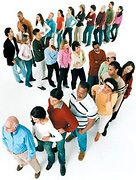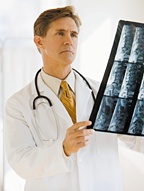Dangerous Curve
By Dr. John Hanks
Did your mother ever nag you to "stand up straight?" Well, that's because she cared about you. What was annoying to mom was the "slumping" posture, so common in our teenage years. But if she had noticed a "side bend" to your spine, she probably wouldn't have nagged at all. She would have taken you to a physician or doctor of chiropractic. And the chances are, that professional would have told you that you had scoliosis. Stand up and look in the mirror. Do you have one shoulder higher than the other? Is your waist uneven or is one hip higher? Does one shoulder blade seem to "stick out" more than the other? Viewed from behind, our backs should be straight, like a flag pole. But with scoliosis, the back may resemble a sapling bending in the wind. There are two basic types of abnormal curvatures. First, the curve may be on a long "C" shaped bend. This was common with those youngsters who contracted polio in the 1950s, primarily because of weak muscles on one side of the spine. The second type of scoliosis is an "S" shape, where the curve "zigs" to one side, then "zags" to the other. The real issue about these curves is, how much do they curve? If your spine is only a little curved, like a slightly bent flag pole, there is probably nothing to worry about. But if it resembles the Snake River in Idaho, it's time for an exam. Scoliosis is not a death sentence, but it can be a significant health challenge. If the abnormal curvatures worsen, the spine can twist and interfere with the nerves coming out between the vertebrae, or spinal bones, as well as just plain hurt. The lungs and diaphragm can be crowded, making breathing more difficult. Straight Talk About Crooked Spines
 Although scoliosis occurs with some diseases such as rickets (a vitamin D deficiency), the Mayo Clinic Health Letter says that 85 percent of scoliosis cases are "idiopathic," or cause unknown. The problem does run in families, and girls are more likely to have scoliosis than boys. Unfortunately, the curvatures tend to also worsen with girls more than boys. The younger the curvatures appear in children, the greater the chance of worsening. The more severe the curve size, the greater the chance of worsening.
Although scoliosis occurs with some diseases such as rickets (a vitamin D deficiency), the Mayo Clinic Health Letter says that 85 percent of scoliosis cases are "idiopathic," or cause unknown. The problem does run in families, and girls are more likely to have scoliosis than boys. Unfortunately, the curvatures tend to also worsen with girls more than boys. The younger the curvatures appear in children, the greater the chance of worsening. The more severe the curve size, the greater the chance of worsening. Scoliosis appears sometime in childhood, usually from age 6 up to the beginning of puberty. Since it's painless, the problem can easily go undetected at first. Visual screening programs at schools have been very valuable in diagnosis, but a definitive diagnosis must be done with a standing, full-spine X-ray. Your doctor will measure the curve. A curve that is only mildly "leaning" probably has an angle of 20 degrees or less and usually does not need treatment at all. Doctors measure the angle of the curves by comparing the "flag pole" position of zero degrees of curvature to the horizontal, or parallel to the floor position of 90 degrees. If the curve is greater than 20 degrees, advice regarding treatment is important. Angles greater than 45 degrees are considered serious. Treatment for scoliosis usually concerns children. If a child still is growing, a brace may be recommended. But, if the skeleton truly has matured, a brace won't help. The worst kind of scoliosis, congenital scoliosis, unfortunately can continue to worsen despite any treatment. Other treatments include electrical stimulation for weak or tight muscles, but have not been shown in studies to be very effective. Surgery often is the last resort for curvatures over 45 degrees and still progressing. Most surgical techniques require the use of rods, screws and wires to stabilize the spine by fusing the vertebrae. Hippocrates (460-380 BC), the Greek father of medicine, had a rather robust treatment for scoliosis. Since straightening the spine seemed to be his goal, he would first suspend a long board between two roofs and have the patient position themselves in the middle, with a rope tied underneath the arms and around the chest. Then, with the other end of the rope tied to the board, Hippocrates would push the patient off. Historical texts do not comment on the effectiveness of this method, nor do they tell of any injury actually suffered by Hippocrates from a vindictive patient. Instead of that dubious method, a better physical treatment approach for scoliosis is chiropractic manipulation. But the idea of hands-on treatment can be confusing. There are many case studies that show actual improvement of modest curvatures with manipulation. However, chiropractors do not claim to "straighten the spine" in the more challenging scoliosis cases. What often is very important in treatment is improving function of the spinal movements, and nerve irritation of large nerves or pain in the nerves of the vertebral joints. In cases of scoliosis, chiropractic physicians are front-line doctors in maintaining proper motion and function of the spinal joints or vertebrae. There are two general categories of techniques used in these cases. One is the hallmark joint manipulation or adjustment, which stretches the joint tissue and releases joint pressure wherever individual vertebrae are locked or fixed. A second category includes muscle and tendon techniques, usually using deep pressure, friction or pinpoint stimulation.
 Scoliosis patients often have problems just fighting gravity. Since the curves can load one side of the body more than the other, muscles shorten on one side and overstretch on the other. Chiropractic muscle techniques create more elasticity in these muscles, thus relieving pain. Joint adjustments restore proper motion. Both of these approaches can be valuable when the large nerves down the arms or legs are pinched, crowded or irritated.
Scoliosis patients often have problems just fighting gravity. Since the curves can load one side of the body more than the other, muscles shorten on one side and overstretch on the other. Chiropractic muscle techniques create more elasticity in these muscles, thus relieving pain. Joint adjustments restore proper motion. Both of these approaches can be valuable when the large nerves down the arms or legs are pinched, crowded or irritated. When scoliosis is severe, chiropractic treatment is even more important because of the threat of muscle and joint degeneration that insidiously occurs over time. One cause of mild to moderate scoliosis is when one leg is shorter than the other. Chiropractic doctors are especially trained to deal with complications of curvatures associated with leg inequality. Sometimes one leg can be shorter (an inch or more) congenitally, with the associated curvature noted especially with standing. But a lesser known, yet common problem is a functional short leg. This is when locking and fixation of spinal joints, or muscle imbalance, actually causes or aggravates a mild scoliosis. Chiropractors are the best practitioners to identify and correct this problem. So, whether it's your children or yourself, when there are questions regarding "funny" curves or imbalances in posture, consult your doctor of chiropractic. And if treatment is appropriate, it will certainly be better than being pushed off a board with a rope tied on your feet. No offense to Hippocrates.
John Hanks, DC, is a board-certified chiropractic orthopedist and is certified as a chiropractic sports physician. He currently serves as the senior chiropractic consultant in the Department of Complementary Medicine, Kaiser Permanente, Rocky Mountain Region.
Page printed from:
http://www.toyourhealth.com/mpacms/tyh/article.php?id=1013&pagenumber=2&no_paginate=true&no_b=true
|

